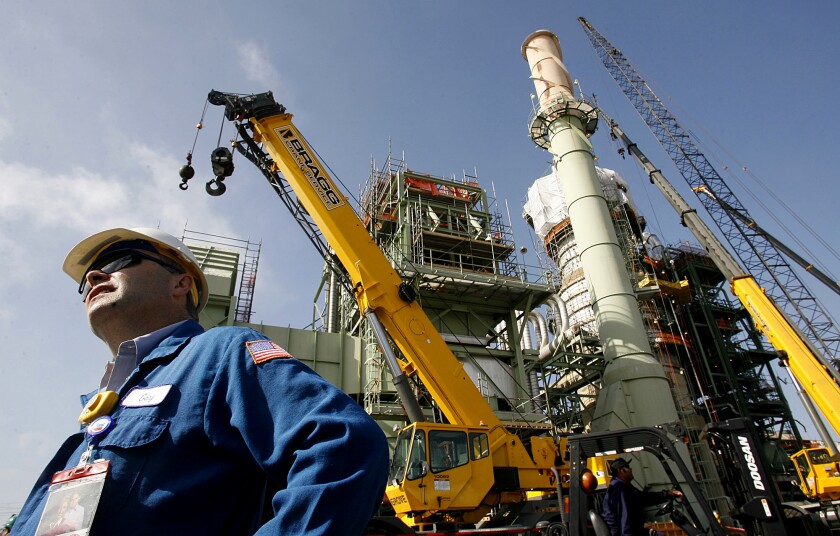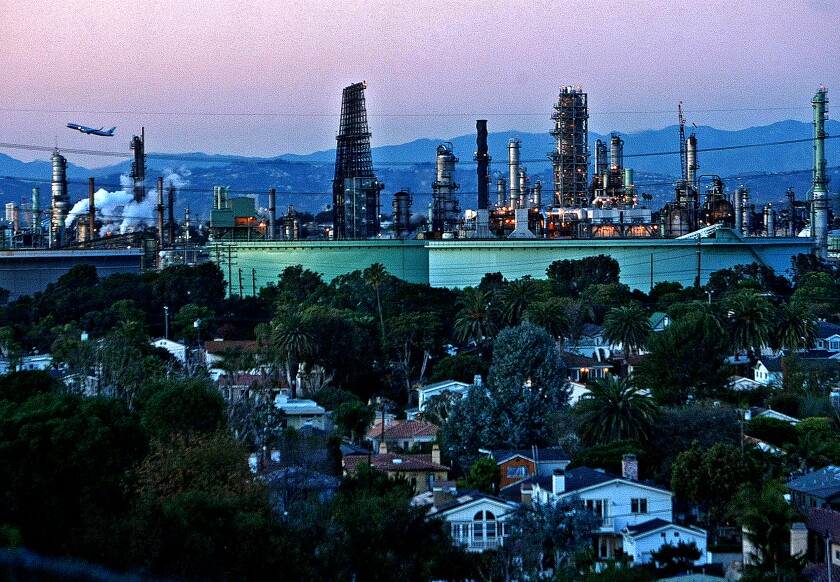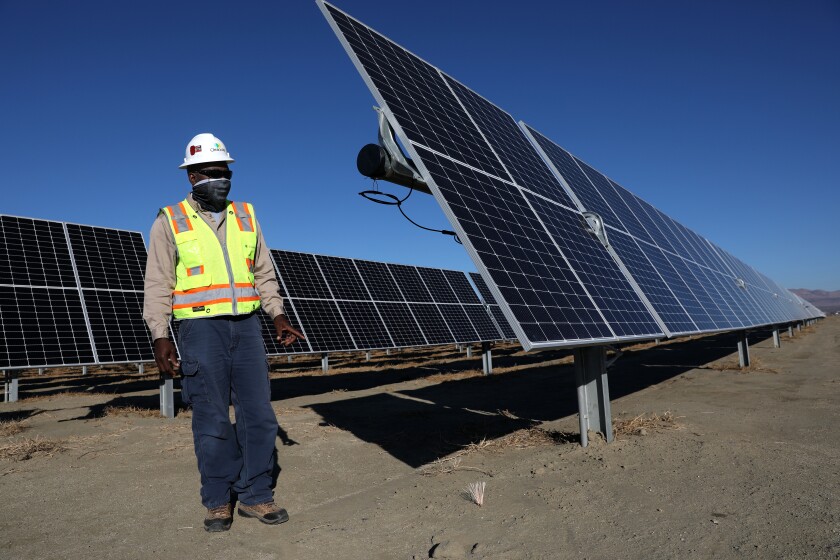Articles Menu

This is the June 10, 2021, edition of Boiling Point, a weekly newsletter about climate change and the environment in California and the American West. Sign up here to get it in your inbox.
The dominant narrative about labor unions and climate change is that fossil fuel workers are a major roadblock to action. There’s good reason for that reputation. In California, building trades unions have fought against limiting oil and gas extraction and won industry-friendly changes to climate policies. Nationally, labor leaders have urged President Biden not to block oil pipelines such as Keystone XL (which was just canceled) and Minnesota’s Line 3 (where the Biden administration sand-blasted protesters this week).
That opposition is driven partly by uncertainty about what comes next if traditional energy jobs go away. It makes perfect sense.
So it’s worth slowing down to examine a groundbreaking new report — endorsed by 19 unions, including two representing thousands of California oil workers — that offers a preview of what the path forward might look like.
This is the first time California has had those kinds of detailed estimates, according to Robert Pollin, an economist at the University of Massachusetts Amherst and the report’s lead author. He and his collaborators calculated the price tag of creating more than 1 million jobs at $138 billion annually, which sounds like a lot until you realize it’s not even 4% of the state’s expected GDP.
An even more encouraging number? The cost of providing an equitable transition to fossil fuel workers who would lose their jobs. After accounting for retirements that would have happened anyway, Pollin found, the price tag comes to $470 million per year, or 0.02% of expected GDP. That money would fund “wage insurance” guaranteeing new jobs with three years’ worth of total pay at the same level as workers’ old fossil fuel employment. It would also cover pension obligations, retraining and relocation.
“If it can be done in California as the opportunity is sitting there for us, it can be done anywhere,” Pollin told me.

Local 675 represents 4,500 workers, about two-thirds of whom have jobs in oil refining and extraction in Los Angeles County. The union’s members staff the Chevron refinery in El Segundo, not far from the L.A. Times office building, as well as refineries owned by Marathon Petroleum, PBF Energy and Phillips 66. They also work the Wilmington oil field for California Resources Corp.
In other words, this isn’t a group you’d expect to get behind climate action. But that’s exactly what they’ve done.
I asked Dave Campbell, secretary-treasurer of Local 675, what was going on. His answer was relatively straightforward: An energy transition is coming whether we like it or not, and it’s crucial that we build a secure future for workers and their families.
“As an oil worker, you’re standing on the track, and you can see the train coming. We can argue about why the training is coming. We can argue about exactly when it’s going to get here. But it’s coming,” he said. “The choice for us is, do we stand on the track and face whatever happens? Or do we get up on the platform and try to catch that train going out of the station?”
Campbell has been on union leave for 25 years, before which he spent two decades at the El Segundo refinery. He acknowledged that giving up good-paying jobs for an unknown future isn’t an easy idea for him and his fellow oil workers to accept. Some union members, he said, “don’t even want to wrap their heads around it. It’s too horrifying for them to think about.”
At the same time, his board kicked in money to help fund the Pollin report and voted unanimously to endorse its conclusions. Campbell cited the recent shutdown of the Marathon refinery in the Bay Area city of Martinez as an eye-opening event.
“Everyone should have a chance to advance in the new economy,” he said. “We shouldn’t have the divisions that we’ve had in the past, with some people having an opportunity and other people having no real opportunity.”
I also spoke with members of two other labor groups endorsing the report. Neither hails from the fossil fuel sector — the only other oil, gas or coal-affiliated union on the list of supporters is United Steelworkers Local 5, which represents Bay Area refinery workers — but their perspectives help to show how the “climate action versus jobs” narrative misses a big piece of the story.
Maribel Castillon is a nurse at the L.A. County Department of Public Health and chair of the environmental justice action team for SEIU Local 721, a branch of the Service Employees International Union. Kelly Mayhew is an English and gender studies professor at San Diego City College and chair of the California Federation of Teachers’ labor and climate justice education committee.
Both of them told me they see their union advocacy as broader than protecting their current jobs.
Castillon’s path to environmental justice activism began with the revelation of rampant lead contamination in Latino communities in southeast L.A. County, stemming from the shuttered Exide battery recycling plant. The more she learned about the pollution, the more she wanted to help in her role as a public health worker. She also heard stories from co-workers dealing with the health consequences of the Porter Ranch methane leak, which involved Southern California Gas Co.'s Aliso Canyon storage facility.
Castillon pointed to scientific research suggesting that air pollution can make people more vulnerable to COVID-19.
“Creating green jobs that are going to be better for all of us — that’s the kind of world I want to live in,” she said.

Mayhew’s job isn’t directly related to energy or pollution. But she teaches a unit on climate change, asking students to research and write about potential solutions — an exercise that might help inform their career choices. As a community college instructor, she’s part of the educational infrastructure that will ultimately need to train people for the clean energy, sustainable agriculture and land restoration jobs of the future. That workforce might include her teenage son, who wants to be an urban planner.
Schools themselves will also need to be retrofitted with clean energy technologies such as solar panels, Mayhew said. That could help clean the air breathed by students, their families and teachers, and save money that could be reinvested in education.
“My interests are inextricably bound to the interests of the students and the interests of the communities I teach in,” she said. “That’s why this report is so exciting to me, because it answers a lot of the questions that my students have.”
The full list of 19 unions endorsing the report is here. They’ve been discussing energy transition issues in California for more than a year and reached out to Pollin after seeing similar research he had done in other states. In addition to Local 675, funding came from the California Federation of Teachers and Local 3299 of the American Federation of State, County and Municipal Employees. Two labor organizations, Jobs With Justice San Francisco and the Labor Network for Sustainability, helped to coordinate.
Here’s the part where I caution that none of this will be easy. When industries such as steel production shrank or went away in the past, the result was typically huge job losses. Just because a less-painful transition is possible doesn’t mean it will happen.
There’s never been such a robust effort to involve labor in planning a fair transition. But public policy is hard, and that’s before politics get in the way. Many fossil fuel workers will never go along with this willingly, and that’s understandable.
There’s also no guarantee that newly created positions in clean energy and other sectors will be the “good-paying, union jobs” that President Biden keeps talking about as he pitches his $2.25-trillion infrastructure plan — or that those jobs will be available to everyone. Pollin listed a bunch of things government can do to help, such as pairing training programs with job placement services, and requiring companies receiving public funds to pay appropriate wages and hire from underrepresented groups.
An expanding labor movement that takes climate seriously is also key, Pollin said. That’s starting to happen. Campbell’s oil-dominated union, Steelworkers Local 675, two years ago organized workers at Proterra’s electric bus factory in L.A. County.
Campbell said it doesn’t necessarily matter to his members if they keep working in energy. A training staffer at a petroleum refinery might have the skill set to become a schoolteacher, for instance, with a few more years of college. Other workers might want to become land surveyors, or civil engineers, or mechanics. Some of Campbell’s members would like to work in forestry.
Getting the transition right is especially important in Contra Costa, Kern and Los Angeles counties — drilling and refining hubs that together account for half of the state’s fossil fuel jobs, according to Pollin’s research. His report includes an entire section on Kern, which has an economy that’s especially dependent on oil and gas — as well as burgeoning solar and wind energy industries.
It’s impossible to make change not scary. But Campbell is optimistic.
“I think the future could be brighter for all of us,” he said.